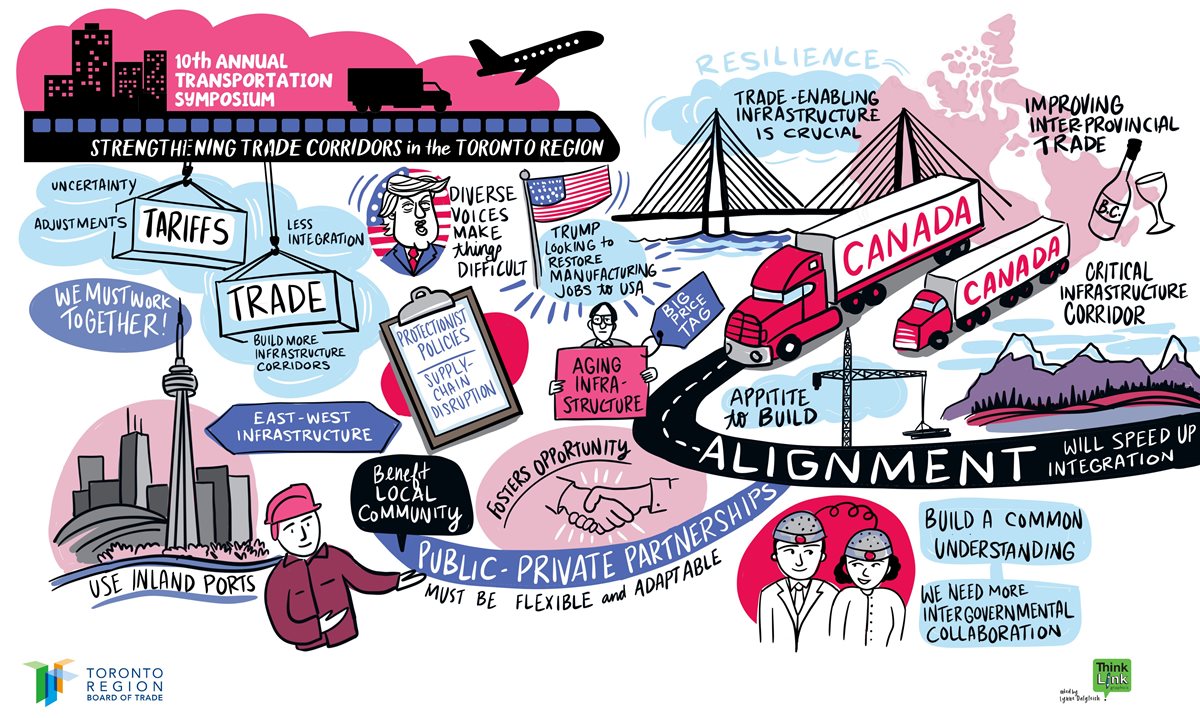The Toronto region is in the middle of a historic scale expansion and modernization of transit and transportation infrastructure, not seen since the 1960s. Building on this scale won’t be easy, which is why the Board brought the industry together to discuss what’s needed and what’s next. The challenge: delivering on time and on budget.
As we heard, fixing how people and goods move across the Toronto region isn’t about tweaking a few projects, it’s about transforming the whole system. All levels of government, all modes of transport, all communities must work together to turn a congested region into a connected one.
That was the focus of the Toronto Region Board of Trade’s 10th Annual Transportation Symposium: From Gridlock to Growth.
- Ambition is not the problem, execution is. With more than 13 major projects in motion, the region must shift from fragmented ecosystems to system-wide, multi-modal coordination.
- Talent is our biggest bottleneck. 100,000 skilled workers will be needed in rail infrastructure alone by 2028. Without investment in training and education, alongside an ongoing commitment to continued investment in projects, delivery timelines are at risk.
- Workforce development must start now. Pooling labour recruitment among the big players—including competitors—and new university partnerships in rail engineering are two big innovations. Greater cross-sectoral buy-in is critical to scale these further.
- Adapting to changing customer preferences, with higher service standards, is key to attracting ridership across all modes of transportation to alleviate congestion. This will be essential to shifting more users out of personal vehicles and onto transit—including on-demand where appropriate—ride share, micro-mobility and active transportation.
- Digital twins and data analytics will allow agencies to simulate traffic flows and plan for future disruptions before they happen. Digital tools are gamechangers, but must overcome barriers to adoption.

15 million
Projected population of the Golden Horseshoe by 2051 (up from 9 million today).
$85B
Projected annual cost of congestion in the GTHA by 2051 if left unaddressed.
13
Major transit projects in the planning or construction stage in the Toronto area alone – from the 15 new stations for the Ontario Line to the new East Harbour Transit Hub and Regional Express Rail
50%
Portion of Canadian rail project budgets spent on soft costs, double that of comparable projects in countries like Italy.
100,000
Skilled workers needed for Canada’s rail infrastructure projects by 2028.
80
Trains per hour Metrolinx is planning to move through Union Station once the east expansion is complete.
Michael Lindsay, Interim CEO, Metrolinx:
“This is open-heart surgery on the city and we’re doing it while the patient is wide awake. We’re undertaking massive, historic expansion projects including 60 kilometres of new rail, 40 kilometres of subway, and Union Station East [the new East Harbour Hub] rising right now. But what’s most important is not just what we’re building, but how we communicate it. People will bear the disruption, they just want to know why.”
Joanne McCall, Senior Vice President, Transportation, AECOM:
“If I had to choose one lever, I would suggest the effort be put into intergovernmental collaboration. Ensuring that happens is critical. Having a common understanding of what project goals are, and agreeing to them early, is absolutely necessary. Too often, negotiations among governments begin before the project is even defined. That leads to delays and unnecessary friction. From the delivery side, I see this all the time. Governments that aren’t aligned create tension and inefficiencies that slow down solutions. If we want to move faster, if we want to get these transformative projects delivered, we need to start by rowing in the same direction from day one.”
Minister Prabmeet Sarkaria:
“Transportation means three things: the creation and protection of good jobs for Ontario workers, fighting gridlock so our families and businesses across the GTA can thrive, and investing in the biggest expansion of public transit in Canadian history. That’s what this government is focused on. And I couldn’t think of a better place to kick off this mandate than in a room full of industry leaders who are helping us get it done.”
Jake Brockman, Senior Public Policy Manager, Uber Canada:
“Transit is and always will be the backbone. But it doesn’t always get you from your front door to your final destination. That’s where we come in. Whether it’s Uber, bike share, walking—those first and last mile connections make or break the user experience. If we want people to choose transit, we need to make sure getting to and from it is seamless, reliable, and fast.”
Ultimately, the region’s infrastructure ambitions are massive. But so is the payoff, if we can get it done. As our President and CEO Giles Gherson said, “We should feel pride in the scale of what’s underway. But pride alone won’t get the job done. We need the skills, the systems, and the commitment to deliver.”



